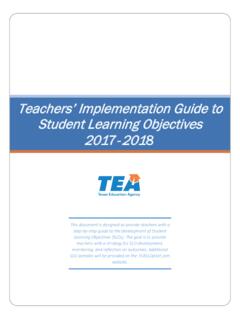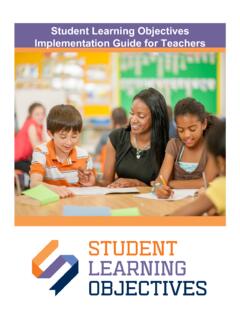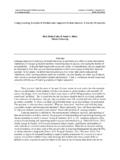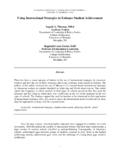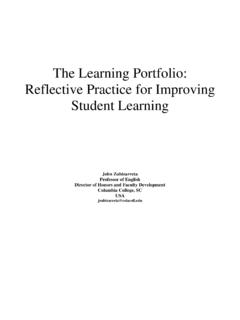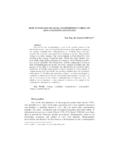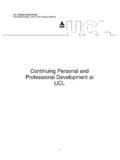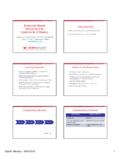Transcription of This document is designed to provide …
1 This document is designed to provide administrators with guidance for implementing the Student learning Objectives (SLOs) process. The goal is to provide administrators with key considerations to facilitate each phase of implementation. Additional resources will be provided on the project website: [This page intentionally left blank.] Table of Contents Vision Statement .. 2 Guiding Principles .. 2 Design Attributes .. 2 What are Student learning Objectives? .. 3 Why use Student learning Objectives (SLOs) as a Measure of Student Growth? .. 3 Getting Started with Student learning Objectives .. 3 A special note about a district s first year of SLO .. 3 The Texas Student learning Objective Process .. 4 Process Overview and Planning Considerations .. 4 Designing and establishing a system of supports for SLO implementation .. 5 Implementation Pre-work .. 5 Key Elements for Campus Leaders.
2 5 Unpacking the Key Elements .. 6 Campus Culture and Capacity .. 6 Expectations and Procedures .. 6 Staff Training .. 6 Access to Data and Resources .. 7 Communication, Timeline, and Technology .. 7 Recommendations for Selecting an Area of Focus .. 10 Guidelines for Selecting the Target Class .. 12 Gathering information about students current level of mastery on selected area of focus .. 12 Supplemental Data Sources .. 14 Data Sources for End-of -Year Skill Level Key Considerations .. 14 Regarding Growth 14 SLO Approval Process .. 16 SLO Approval Process Other Key Considerations .. 17 Phase 2: A Continuous Cycle .. 20 MOY Conference .. 20 Teacher Reflection .. 22 EOY Conference .. 22 Guidance for End-of -Year Conferences: .. 23 Appendix A: District Decision Worksheet .. 25 Appendix B: Planning Worksheet for School-Based Leaders .. 30 Appendix C: Student learning Objective Form .. 34 Appendix D: Student Growth Tracker.
3 38 Appendix E: SLO Rating Rubrics .. 39 Appendix F: SLO Quality Tool .. 41 Appendix G: Progress Discussion Notes (Optional) .. 43 Appendix H: End-of -Year Reflection .. 44 Appendix I: Definitions for the SLO Process .. 45 SLO Implementation Guide for Administrators | July 2016 2 | P a g e Vision Statement The Student learning Objective (SLO) model in Texas provides a framework for continuous dialogue between students, teachers and principals to support teacher development and student growth throughout the year. Guiding Principles Support Growth and Development: provide a meaningful framework to support student growth and teacher development. Support Local Autonomy: provide flexibility for districts, campuses, and classrooms to adapt as needed. Design Attributes Instructionally Valuable: Support educators to make responsive instructional decisions throughout the year. Standards-Aligned: Address academic standards that are critical to student learning .
4 Equitable: Meet the unique needs of all students and teachers. Transparent: Be clear, concise and easily understood. Manageable: Be easily incorporated into and enhance existing methods for measuring student learning . Using this The purpose of this Student learning Objective Handbook is to provide implementation guidance for campus administrators. This guidance is not designed as a stand-alone resource for SLO implementation but should accompany training on the SLO process and support throughout the year. The design of this SLO model was driven by the Texas Student learning Objective Advisory Committee, comprised of classroom teachers, principals, central office administrators, and Educational Service Center staff. The Texas Education Agency s goal is to assist districts in implementing a model that continually supports teacher development and is instructionally valuable for teachers and students. SLO Implementation Guide for Administrators | July 2016 3 | P a g e What are Student learning Objectives?
5 Excellent teachers regularly set learning goals for their students and use a variety of data sources to monitor progress towards these goals throughout the year. The Student learning Objectives process aims to capture this best practice as a means to allowing teachers and teacher appraisers to determine and reflect on a teacher s pedagogical strengths and areas for growth. Student learning Objectives are: Student growth goals Set by teachers Focused on a foundational student skill that is developed throughout the curriculum Tailored to the context of individual students designed to help teachers better understand the impact of their pedagogy For the purposes of refining instruction. Why use Student learning Objectives (SLOs) as a Measure of Student Growth? SLOs drive both teacher practice and student learning by strengthening instruction. The use of SLOs has been associated with improved student outcomes on standardized assessments.
6 Teachers crafting SLOs report improved understanding of how to use data to determine student needs and to measure progress toward goals. SLOs encourage collaboration among teaching peers as well as between teachers and their appraisers. And, SLOs encourage the adoption of a long-term vision for student learning and contribute to more meaningful discussions about vertical planning. The SLO Process represents a continuous cycle of improvement embodied in strong teaching practice. Teachers and their appraisers will use SLOs to design strategies to meet their goals for student success, beginning with planning and leading to thoughtful instructional design and delivery. Throughout the year, teachers will collect evidence of student learning and adjust instruction accordingly. At the end of the cycle, teachers will reflect on outcomes and plan to refine their practice for the following year. Getting Started with Student learning Objectives Student learning Objectives provide an effective process for improving instructional practices by encouraging thoughtful, deliberate, and evidence-based decisions that should ultimately result in improved student learning .
7 Like any research-based practice, however, the impact of the process is greatly influenced by the quality of the implementation. For teachers, the process begins with determining the focus of the SLO and then basically mirrors what we know about effective teaching as it progresses. For administrators, however, the process begins with an informal assessment of current campus capacity in key aspects of the process to guide the development of systems of support to facilitate implementation. The purpose of this guide is to help administrators support teachers in this valuable work. A special note about a district s first year of SLO While SLOs are a mostly intuitive process for teachers, achieving smooth and consistent implementation district-wide works best with a coordinated effort from multiple departments across the organization. For the first year of implementation, districts are strongly encouraged to maintain focus on the core aspects of SLOs and implementing the process with quality, both of which lead to valuable teacher reflection and the resulting adjustment of instructional practice.
8 SLO Implementation Guide for Administrators | July 2016 4 | P a g e The Texas Student learning Objective Process Process Overview and Planning Considerations The Student learning Objective process should be used throughout the school year to help teachers plan backward from an end vision for student success. This process helps encourage regular conversations and collaboration between teachers, students, and appraisers in order to ensure that instruction facilitates students progress toward growth goals. The SLO process represents a continuous cycle of improvement embodied in strong teaching practice. Teachers and their appraisers will use SLOs to design strategies to meet their goals for student success, beginning with planning and leading to thoughtful instructional design and delivery. Throughout the year, teachers will collect evidence of student learning and adjust instruction accordingly. At the end of the cycle, teachers will reflect on outcomes and plan to refine their practice for the following year.
9 For ease of understanding, the SLO process has been grouped into three key phases to define the sequence of actions to be taken. Phase 1: Creating a Student learning Objective The first phase focuses on purposeful planning of instruction. At the beginning of the course, teachers work with each other, their appraisers, and other support staff to identify foundational skills to address, create an instructional plan, and identify student starting points as the SLO is crafted. During this phase, teachers will develop and articulate a clear vision for student growth and strategies to be used to monitor progress toward those goals. Phase 2: Monitoring Progress to Drive Instruction After the Student learning Objective is completed and approved by the appraiser, teachers will work with each other and their appraiser, engaging in ongoing dialogue about progress toward goals. These discussions will also be opportunities for teachers to receive feedback and support, and to develop strategies to adjust instruction based on progress monitoring findings.
10 To improve efficiency in implementation, SLO processes should be integrated into existing support frameworks at each school. Phase 3: Evaluating Success and Reflection This last phase takes place at the end of the course and includes a conversation between the teacher and his or her appraiser regarding the quality of the SLO, the level of expectations for student growth, the teacher s effectiveness at monitoring students progress and adjusting instruction, and how well students did in meeting or exceeding growth targets. This conversation results in an overall rating that is based on these factors. The final conversation is designed to help teachers and appraisers reflect on student progress and teacher practice throughout the course in order to plan for the refinement of instruction for the following year. SLO Implementation Guide for Administrators | July 2016 5 | P a g e Designing and establishing a system of supports for SLO implementation Implementation Pre-work Prior to teachers beginning their work on Phase 1 of the SLO process, campus administrators, working in conjunction with district administration, lay the groundwork for successful implementation of the SLO process through their work on the District- and Campus-Level Decisions worksheets (see Appendices A and B).
